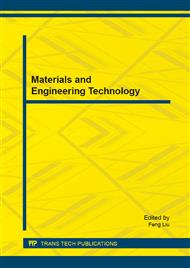[1]
K.S. Novoselov, A.K. Geim, S.V. Morozov, Two-dimensional gas of massless Dirac fermions in graphene, Nature 438 (2005) 197-200.
DOI: 10.1038/nature04233
Google Scholar
[2]
A.K. Geim, K.S. Novoselov, The rise of graphene, Nat. Mater. 6 (2005) 183-191.
Google Scholar
[3]
A.A. Balandin, S. Ghosh, W.Z. Bao, Superior thermal conductivity of single-layer graphene, Nano Lett. 3 (2008) 902-907.
DOI: 10.1021/nl0731872
Google Scholar
[4]
D. Dragoman, M. Dragoman, Giant thermoelectric effect in graphene, Appl. Phys. Lett. 91 (2007) 203116.
DOI: 10.1063/1.2814080
Google Scholar
[5]
A. Bello, K. Makgopa, M. Fabiane, Manyala Chemical adsorption of NiO nanostructures on nickel foam-graphene for supercapacitor applications, J. Mater. Sci. 48 (2013) 6707-6712.
DOI: 10.1007/s10853-013-7471-x
Google Scholar
[6]
C.G. Rhet, J.H. Yang, M.C.C. Mark, A silicon nanoparticle/reduced graphene oxide composite anode with excellent nanoparticle dispersion to improve lithium ion battery performance, J. Mater. Sci. 48 (2013) 4823-4833.
DOI: 10.1007/s10853-012-7094-7
Google Scholar
[7]
P.T. Xu, J.X. Yang, K.S. Wang, Porous graphene: Properties, preparation, and potential applications, Chin. Sci. Bull. 23 (2012) 2948-2955.
DOI: 10.1007/s11434-012-5121-3
Google Scholar
[8]
A.J. Du, Z.H. Zhu, S.C. Smith, Multifunctional porous graphene for nanoelectronics and hydrogen storage: new properties revealed by first principle calculations, J. Am. Chem. Soc. 132 (2012) 2876-2877.
DOI: 10.1021/ja100156d
Google Scholar
[9]
G.Q. Ning, Z.J. Fan, G. Wang, Gram-scale synthesis of nanomesh graphene with high surface area and its application in supercapacitor electrodes, Chem. Commun. 47 (2011) 5976-5978.
DOI: 10.1039/c1cc11159k
Google Scholar
[10]
D.E. Jiang, V.R. Cooper, S. Dai, Porous graphene as the ultimate membrane for gas separation, Nano Lett. 12 (2009) 4019-4024.
DOI: 10.1021/nl9021946
Google Scholar
[11]
S. Blankenburg, M. Bieri, R. Fasel, Porous graphene as an amospheric nanofilter, Small 20 (2010) 2266-(2071).
DOI: 10.1002/smll.201001126
Google Scholar
[12]
H.W.C. Postma, Rapid sequencing of individual DNA molecules in graphene nanogaps, Nano Lett. 10 (2010) 420-425.
DOI: 10.1021/nl9029237
Google Scholar
[13]
M.D. Fischbein, M. Drndić, Electron beam nanosculpting of suspended graphene sheets, Appl. Phys. Lett. 93 (2008) 113107.
DOI: 10.1063/1.2980518
Google Scholar
[14]
M. Bieri, M. Treier, J.M. Cai, Porous graphenes: two-dimensional polymer synthesis with atomic precision, Chem. Commun. 45 (2009) 6919-6921.
DOI: 10.1039/b915190g
Google Scholar
[15]
Y.W. Zhu, S. Murali, M.D. Stoller, Carbon-based supercapacitors produced by activation of graphene, Science 332 (2011) 1537-1541.
Google Scholar
[16]
L.S. Weng, L.Y. Zhang, Y.P. Chen, Atomic force microscope local oxidation nanolithography of graphene, Appl. Phys. Lett. 93 (2008) 093107.
DOI: 10.1063/1.2976429
Google Scholar
[17]
S.S. Datta, D.R. Strachan, S.M. Khamis, Crystallographic etching of few-layer graphene, Nano Lett. 8 (2008) 1912-(1915).
DOI: 10.1021/nl080583r
Google Scholar
[18]
D.C. Bell, M.C. Lemme, L.A. Stern, Precision cutting and patterning of graphene with helium ions, Nanotechnology 20 (2009) 455301.
DOI: 10.1088/0957-4484/20/45/455301
Google Scholar
[19]
M.A. Lillo-Rodenas, J. Juan-Juan, D. Cazorla-Amoros, About reactions occurring during chemical activation with hydroxides, Carbon 42 (2004) 1371-1375.
DOI: 10.1016/j.carbon.2004.01.008
Google Scholar
[20]
B. Xu, Y.F. Chen, G. Wei, Activated carbon with high capacitance prepared by NaOH activation for supercapacitors, Mater. Chem. and Phys. 124 (2010) 504-509.
DOI: 10.1016/j.matchemphys.2010.07.002
Google Scholar
[21]
L.T. Ru, Mesopore control of high surface area NaOH-activated carbon, J. Colloid. Interf. Sci. 303 (2006) 494-502.
DOI: 10.1016/j.jcis.2006.08.024
Google Scholar
[22]
M.A. Lillo-Rodenas, D. Cazorla-Amoros, A. Linares-Solano, Understanding chemical reactions between carbons and NaOH and KOH an insight into the chemical activation mechanism, Carbon 41 (2003) 267-275.
DOI: 10.1016/s0008-6223(02)00279-8
Google Scholar
[23]
D. Yang, G.Q. Guo, J.H. Hu, Hydrothermal treatment to prepare hydroxyl group modified multi-walled carbon nanotubes, J. Mater. Chem. 18 (2008) 350-354.
DOI: 10.1039/b713467c
Google Scholar



